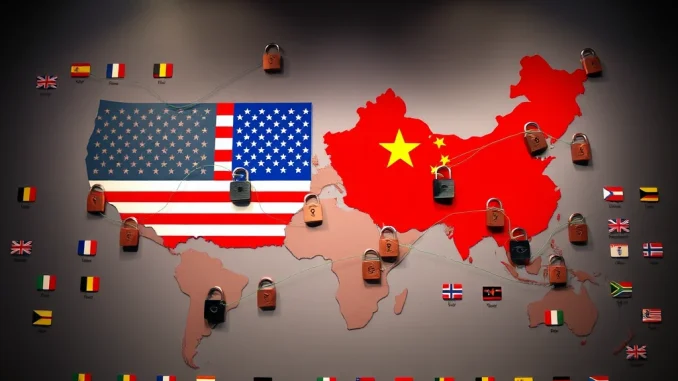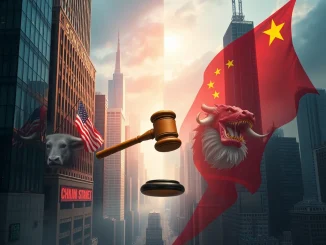
In a move that could dramatically reshape global trade flows, the United States is reportedly engaging in high-stakes negotiations with over 70 countries. The aim? To construct a formidable alliance aimed at curbing China’s export capabilities. This news, first brought to light by Walter Bloomberg on X (formerly Twitter) citing a Wall Street Journal report, sends shockwaves through international markets and raises critical questions about the future of global commerce. For cryptocurrency enthusiasts and investors, understanding these macroeconomic shifts is paramount as they can significantly influence market sentiment and asset valuations. Let’s dive deep into what this aggressive US strategy entails and what it could mean for the world.
Why is the US Targeting China Exports? Understanding the Trade Tensions
The backdrop to this aggressive strategy is the ongoing and increasingly complex trade relationship between the United States and China. For years, concerns have been mounting in Washington regarding China’s trade practices, intellectual property rights, and the sheer scale of its exports. The US has long accused China of unfair trade practices, including:
- Intellectual Property Theft: Allegations that China has systematically stolen intellectual property from US companies, costing billions of dollars.
- Forced Technology Transfer: Concerns that China requires foreign companies to share technology in exchange for market access.
- State-Sponsored Subsidies: Accusations that the Chinese government heavily subsidizes its industries, giving them an unfair advantage in global markets.
- Trade Imbalances: The significant trade deficit the US has with China has been a long-standing point of contention.
These issues have fueled a desire within the US government to rebalance the trade relationship and reduce dependence on Chinese goods in certain strategic sectors. The move to negotiate with 70 countries to limit China exports is seen as a significant escalation in this ongoing trade friction.
The 70-Country Alliance: How Will Trade Negotiations Work?
The sheer scale of negotiating with 70 countries highlights the ambitious nature of the US plan. But how exactly will these trade negotiations unfold? While details are still emerging, we can anticipate several key aspects:
- Bilateral Discussions: The US is likely engaging in separate bilateral talks with each of the 70+ nations. This allows for tailored approaches based on each country’s specific trade relationship with China and the US.
- Incentives and Pressure: The US will likely employ a combination of incentives (such as increased trade access to the US market) and pressure (potential tariffs or trade restrictions) to encourage these countries to cooperate.
- Focus on Specific Sectors: The negotiations may not aim for a blanket ban on all China exports. Instead, they could target specific sectors deemed strategically important, such as technology, semiconductors, or critical minerals.
- Coordination and Harmonization: A key challenge will be ensuring that the 70+ countries adopt somewhat harmonized approaches to avoid China simply rerouting exports through nations with less stringent restrictions.
Table: Potential Negotiation Strategies
| Strategy | Description | Potential Impact on China Exports |
|---|---|---|
| Increased Tariffs | Participating countries raise tariffs on specific Chinese goods. | Directly reduces the competitiveness of China exports in those markets. |
| Import Quotas | Setting limits on the quantity of certain Chinese goods that can be imported. | Caps the volume of China exports, even if prices are competitive. |
| Export Controls | Participating countries restrict the export of certain technologies or goods to China. | Limits China’s access to key inputs for its export industries. |
| Supply Chain Diversification Incentives | Offering incentives for companies to move production and sourcing away from China. | Gradually reduces reliance on China as a manufacturing hub. |
Global Trade Implications: Beyond US-China Relations
This US initiative extends far beyond just US-China relations. It has profound implications for global trade as a whole. Here’s a look at some of the broader consequences:
- Supply Chain Restructuring: Companies worldwide may need to further diversify their supply chains to mitigate risks associated with potential disruptions to China exports. This could lead to increased costs and complexity.
- Geopolitical Realignment: The negotiations could further solidify geopolitical blocs, with countries potentially feeling pressure to align more closely with either the US or China.
- Inflationary Pressures: Restricting access to potentially lower-cost Chinese goods could contribute to inflationary pressures in participating countries.
- Impact on Developing Nations: Many developing countries rely on trade with both the US and China. Navigating these new trade dynamics will be crucial for their economic growth.
- Potential for Retaliation: China is likely to respond to these measures, potentially leading to retaliatory actions that could further escalate trade tensions and harm global economic growth.
Economic Sanctions and Cryptocurrency: A Tangled Web?
While the news focuses on trade, the concept of economic sanctions is closely related. Sanctions are often used as a tool in international relations to exert economic pressure. The US strategy to limit China exports can be viewed as a form of economic pressure, albeit through negotiated agreements rather than unilateral sanctions.
So, how does this all tie into cryptocurrency? Here’s where things get interesting:
- Safe Haven Asset Narrative: Increased global economic uncertainty, driven by trade tensions and potential sanctions, can strengthen the narrative of Bitcoin and other cryptocurrencies as safe haven assets. Investors may seek refuge in decentralized assets perceived as less correlated with traditional markets.
- Inflation Hedge: If trade restrictions lead to inflationary pressures, as mentioned earlier, cryptocurrencies like Bitcoin, often touted as a hedge against inflation, could see increased demand.
- Decentralized Finance (DeFi) and Cross-Border Transactions: In a world of fragmented trade and potential sanctions, DeFi and cryptocurrencies could offer alternative channels for cross-border transactions, potentially bypassing traditional financial systems that are more susceptible to political influence.
- Regulatory Scrutiny: Governments worldwide are already increasing regulatory scrutiny of cryptocurrencies. Heightened geopolitical tensions and economic uncertainties could further accelerate this trend as governments seek to maintain control over financial flows.
Actionable Insights: Navigating the Shifting Trade Landscape
For individuals and businesses operating in the cryptocurrency space, staying informed about these global trade developments is crucial. Here are some actionable insights:
- Monitor Geopolitical News: Keep a close watch on news related to US-China trade relations and the progress of these trade negotiations with 70 countries.
- Assess Supply Chain Risks: If your crypto business relies on global supply chains, particularly those involving China, assess potential risks and explore diversification strategies.
- Consider Safe Haven Assets: Evaluate the potential role of cryptocurrencies as safe haven assets in your investment portfolio, especially if you anticipate increased economic volatility.
- Stay Updated on Regulations: Be prepared for potential shifts in cryptocurrency regulations as governments respond to evolving geopolitical and economic landscapes.
Conclusion: An Urgent Shift in Global Trade Dynamics
The US plan to negotiate with 70 countries to limit China exports represents a potentially seismic shift in global trade dynamics. This aggressive strategy, driven by long-standing trade tensions, could reshape supply chains, realign geopolitical forces, and introduce new uncertainties into the global economy. While the full implications are yet to unfold, one thing is clear: the world is entering a new era of trade relations, and understanding these shifts is vital for navigating the future – including the ever-evolving world of cryptocurrency. The urgency of this situation cannot be overstated, and its impact will likely be felt across various sectors for years to come. Stay informed, stay agile, and prepare for a world where trade is no longer business as usual.



